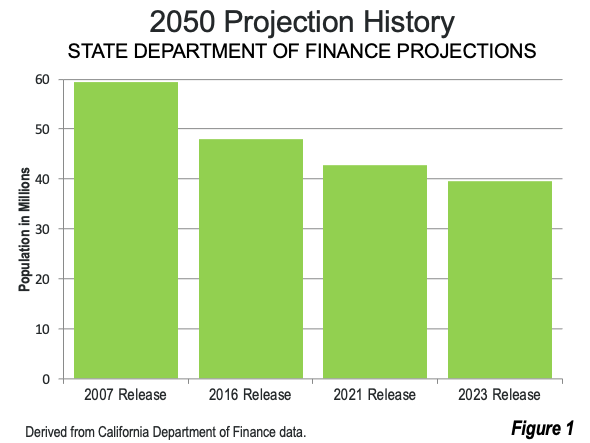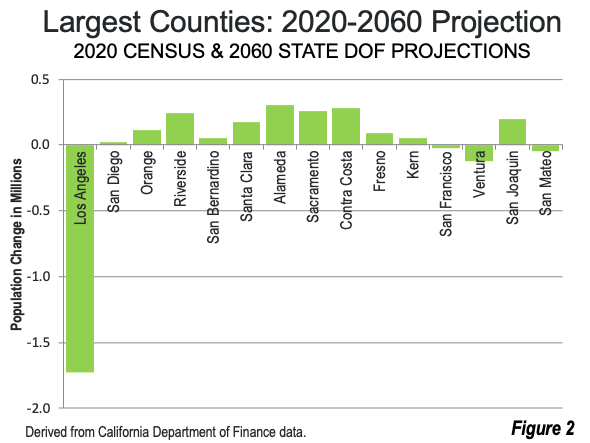
The state of California Department of Finance (DOF) has issued interim population projections indicating that in 2060, there will be 39,508,000 residents in the state. This is 12,000 fewer residents than in 2020 (39,520,000). This is astounding given the state’s strong growth through its first 150 years (1850 to 2000), during which it achieved the nation’s largest population.
Leaving California
Yet despite its splendid weather and spectacular scenery, people are leaving California in droves. Just in the 27 months between the 2020 Census and the 2022 US Census Bureau population estimates, a net 871,000 net domestic migrants have moved to other parts of the United States. This is more residents than live in the city of San Francisco (808,000), according to the Census Bureau. Of course more Californians stayed than moved, but if California had experienced similar migration trends throughout its history, it would never have become the nation’s largest state.
This exodus is of long standing. Net domestic migration away from California between 2000 to 2022 was near 3.5 million, almost as many people as live in the city of Los Angeles, the largest in the state and second largest in the nation.
The new projections for 2060 are 4.7 million residents lower than the Department of Finance projections issued just two years ago. This amounts to more people than live in 26 states. The comparison with previous projections is even more stark. In 2007, the Department of Finance projected a 2050 population of 59.5 million residents (Figure 1). Even at a time of faster growth, this seemed high, as I wrote in an Orange County Register op-ed (“California Focus: 60 Million Californians: Don’t Bet on It”).

The new 2050 projection is for California to have 40.0 million residents. This is a 19.5 million drop from the 2008 release projection. The reduction is nearly equal to the entire population of the state of New York, which had the largest population in the nation for nearly 170 years (1810 to the late 1960s). This is a stunning reduction in expectations for a state that has epitomized massive population growth far more than any other state the early 20th century.
County Projections: Plummeting Los Angeles County Population
The Department of Finance release also provided county projections. The real loser is Los Angeles County, where the population is projected to drop from 10,013,000 in 2020 to 8,284,000 in 2060, a loss of 1,729,000. The last time Los Angeles County had this few residents was in 1985.
The rest of the state is projected to gain 1,718,000. Los Angeles County would be the only county among the 2020 top 12 to lose population. San Francisco County, ranked 13th in 2020, is projected to have a more modest drop from 870,000 to 845,000. Number 14 Ventura County would also lose population, while number 15 San Joaquin County (county seat Stockton) would gain from 780,000 to 976,000, overtaking San Francisco County (Figure 2).

The largest numeric gain among the 58 counties is projected to be in Alameda County, at 301,000 (18.0%), followed by Contra Costa County, at 279,000 (24%). Both counties lie across the Bay Bridge from the city of San Francisco. Sacramento County would gain 257,000 residents (16.2%), while Riverside County would gain 239,000 (9.9%).
Metropolitan Areas and Other Regions
The five county Los Angeles combined statistical area (Los Angeles, Orange, Riverside, San Bernardino and Ventura Counties) would fall in population from 18.7 million in 2020 to 17.2 million in 2060, a loss of 1.5 million residents (minus 7.8%).
The San Francisco Bay Area would gain from 8.0 million in 2020 to 8.7 million in 2060 (7.9%). This includes Alameda, Contra Costa, Marin, Napa, San Benito, San Francisco, San Mateo, Santa Clara, Santa Cruz, Solano and Sonoma counties. This is a different definition than the Bay Area combined statistical area, which also includes the San Joaquin Valley (Central Valley) counties of Merced, San Joaquin and Stanislaus. These counties are included in the Central Valley for the purposes of this article (below).
The Central Valley (San Joaquin Valley and Sacramento Valley) would rise in population from 7.2 million in 2020 to 8.1 million in 2060 (12.2%).
San Diego County, which is also the San Diego metropolitan area, would have a small increase of 0.6%, remaining at 3.3 million.
Metro Riverside-San Bernardino: More Populous than Metro San Francisco: Demonstrating the difficulty of projecting population, especially due to unforeseen circumstances, DOF had projected that the San Francisco metropolitan area (Alameda, Contra Costa, Marin, San Francisco and San Mateo counties) would remain the state’s second largest metropolitan area in 2060. The dispersion related to the pandemic led to greater population growth in the Riverside-San Bernardino metropolitan area, which has passed San Francisco to take over second place, leading San Francisco by 88,000 in 2022, according to the US Census Bureau.
Racial and Ethnic Projections
The DOF release also included racial and ethnic projections. In recent years, Hispanics have become more numerous in the state than White Non-Hispanics. The projections anticipate little change in the ratio. In 2020, the Hispanic population of California was 39.9%, which is projected to fall to 39.3% in 2060. The White Non-Hispanic population would rise from 35.5% in 2020 to 35.8%. The White Non-Hispanic population would increase over the period by 108,000 residents, while the Hispanic population would drop by 191,000.
The Asian population would increase from 6.1 million in 2020 to 6.2 million in 2060, with a small percentage gain from 15.4% to 15.6%. The Black population would remain at 2.2 million, a share of 5.6% in both years.
Surprises and Observations
I was, however surprised by some results.
The first is racial and ethnic trends, Hispanics became the largest ethnic or racial group in the last decade, gaining 12% in population since 2010, according to the Census Bureau. White-Non-Hispanics, which were formerly more numerous, fell to second place, losing 24% since 2010. At the same time the number of Non-Hispanic Asians grew by 25%, or 99,000. I would have expected a trend more consistent with the recent trends of greater population growth among Hispanics and Asians and greater losses among White-Non-Hispanics.
I was also surprised at the concentration of population loss in Los Angeles County. I would have expected a more even distribution among the counties with higher urban densities.
The new more modest projections are to be expected, given the decades of uninterrupted net domestic migration losses. Then there is the intractable cost of living crisis, principally driven by the housing affordability crisis, and rapidly falling birth rate. Taking all this into consideration, the apparent no-growth future of California is not a surprise.
Wendell Cox is principal of Demographia, an international public policy firm located in the St. Louis metropolitan area. He is a founding senior fellow at the Urban Reform Institute, Houston, a Senior Fellow with the Frontier Centre for Public Policy in Winnipeg and a member of the Advisory Board of the Center for Demographics and Policy at Chapman University in Orange, California. He has served as a visiting professor at the Conservatoire National des Arts et Metiers in Paris. His principal interests are economics, poverty alleviation, demographics, urban policy and transport. He is co-author of the annual Demographia International Housing Affordability Survey and author of Demographia World Urban Areas.
Mayor Tom Bradley appointed him to three terms on the Los Angeles County Transportation Commission (1977-1985) and Speaker of the House Newt Gingrich appointed him to the Amtrak Reform Council, to complete the unexpired term of New Jersey Governor Christine Todd Whitman (1999-2002). He is author of War on the Dream: How Anti-Sprawl Policy Threatens the Quality of Life and Toward More Prosperous Cities: A Framing Essay on Urban Areas, Transport, Planning and the Dimensions of Sustainability.
Photo: Sacramento Capitol building by Andre M., Wikimedia, CC 3.0 License.













LA County
Do the local planners have any projections that come close to this 1.8 million population loss? It would necessarily involve decimation of some municipalities.